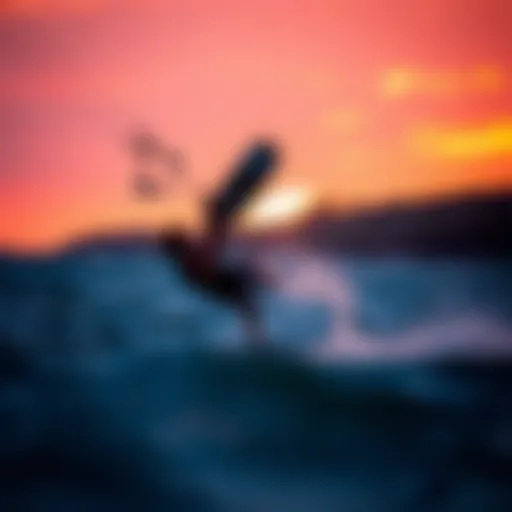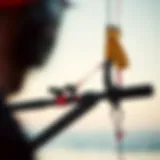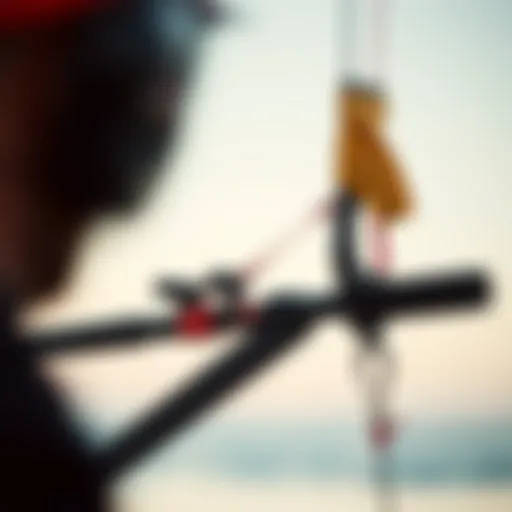Weather Radar Insights for Kiteboarding in Eastpoint, FL


Intro
Kiteboarding in Eastpoint, Florida, is not just about the wind and water. Understanding the weather radar can mean the difference between a smooth ride and a rough day on the waves. With ever-changing conditions, it's crucial for enthusiasts to be savvy about local weather patterns. Weather radar serves as a powerful tool for kiteboarders, giving insight into what to expect out on the water.
Eastpoint's coastal location adds an extra layer of complexity to weather forecasting. With the gulf breeze mixing with inland weather systems, conditions can shift rapidly. This unpredictability emphasizes the importance of mastering how to interpret radar data. It's not just about feeling the wind; it’s about seeing the bigger picture. Through this article, we aim to provide necessary knowledge, transforming kiteboarding from a mere hobby into a well-informed adventure.
Gear Selection
Selecting the right gear holds significant weight when it comes to kiteboarding effectively and safely. Every kiteboarder, from beginners to experienced riders, should consider their equipment’s compatibility with local weather conditions. Here’s a breakdown on some vital components to consider in your gear selection:
Types of Kites
The kite itself is the heart of the kiteboarding experience. Different types of kites serve varied purposes and conditions:
- C Kites: Known for their performance and stability, they’re great for big air tricks, but require skill to control in gusty winds.
- Bow Kites: These kites provide a larger wind range and are easier to handle, making them suitable for newcomers.
- Delta Kites: Their unique shape lends itself well to light wind conditions, ensuring a better flying experience.
Choosing the right kite enhances both your safety and enjoyment on the water. Knowledge of the wind forecast from the regional radar can direct your choice significantly.
Choosing the Right Board
The board is equally important. Much like the kite, selecting a board that suits your style and the conditions is key:
- Freestyle Boards: These are shorter and designed for tricks. They require a significant amount of power and control from your kite.
- All-Around Boards: Ideal for a mix of conditions and styles. They offer a good balance of performance and comfort.
- Directional Boards: These boards are for those who enjoy strapless riding and can handle waves better in choppy water.
Adapting to weather radar information can lead you to make informed decisions when selecting the ideal board for the conditions at hand.
Weather radar acts as your compass in kiteboarding. Understanding its report gives you the edge in choosing suitable gear and capitalizing on the best kiteboarding conditions.
Skill Development
Beyond gear, skill development is essential for enjoying smooth rides. Understanding your limits and focusing on essential techniques will widely improve both enjoyment and safety.
Essential Techniques
In kiteboarding, mastering fundamental techniques like kite control and body positioning is crucial. These skills ensure you can navigate varying wind conditions and waves with finesse. Practicing these can elevate your overall experience.
- Kite Control: Practicing flying your kite on land can teach you handling skills that'll translate to water.
- Body Positioning: Keeping your weight centered improves balance and will help manage the board easier in wind gusts.
Progression Tips
To become a proficient kiteboarder, aim for gradual progression. It’s tempting to jump straight into advanced maneuvers, but patience yields better long-term results. Document your experiences, set achievable goals, and progressively challenge yourself. Use weather radar data to determine ideal days for practice, maximizing your learning.
Understanding the intricacies of weather radar enhances not just your kiteboarding experience but also ensures safe navigation through changing conditions. Whether you’re just starting or looking to refine your skills, adapting to local weather patterns means equipping yourself for success on the water.
Preamble to Weather Radar
Weather radar plays a pivotal role in understanding and predicting atmospheric conditions, particularly in areas where outdoor activities rely heavily on weather patterns, such as Eastpoint, Florida. For kiteboarders, grasping the intricacies of weather radar can significantly influence their experience on the water. It not only aids in ensuring safety but also enhances the excitement of the sport by allowing enthusiasts to choose optimal conditions for their sessions.
Definition and Purpose
Weather radar is a technological tool that utilizes radio waves to detect precipitation, wind, and other weather phenomena across various regions. At its core, this technology sends out a pulse of energy and measures the reflected signals that bounce off raindrops, snowflakes, or even airborne debris. By interpreting these reflected signals, meteorologists can estimate the intensity, location, and movement of weather systems.
The primary purpose of weather radar, particularly for kiteboarders, is to provide real-time data that helps them make informed decisions about going out on the water. Knowledge of upcoming storms, wind direction, and precipitation can be crucial, especially when the weather can change on a dime—one moment it’s sunny, and the next, a storm rolls in.
Types of Weather Radar
Weather radar systems come in various types, each serving unique functions. Understanding these types can help kiteboarders get a clearer picture of the atmospheric conditions:
- Doppler Radar: This type is prevalent and measures the velocity of precipitation, allowing users to determine wind speed and direction. It’s particularly beneficial for kiteboarders, as knowing wind patterns is critical for their sport.
- Pulse Radar: Also known for its short bursts of energy, pulse radar is great for depicting detailed precipitation data within a narrow time frame. This can be advantageous for real-time analysis during a kiteboarding session.
- Phased Array Radar: Phased array radar can rapidly scan large areas and provide 3-D views of weather. Although more advanced and often costly, its ability to assess vertical profiles of storms can be useful for predicting gusts or changes in weather systems.
By keeping an eye on the radar and understanding these systems, kiteboarders in Eastpoint can become adept at interpreting weather data. This not only equips them to plan their outings more effectively but also contributes to safer experiences on the water. Understanding weather radar isn’t just about recognizing precipitation; it’s about harnessing a tool that can elevate the kiteboarding experience.
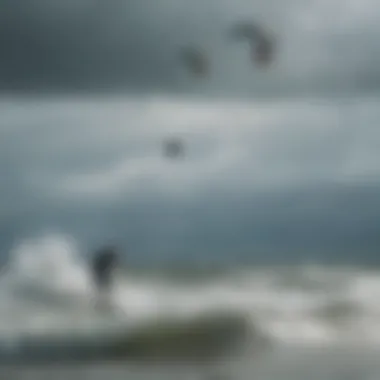

Weather Radar in Eastpoint, FL
When we think about kiteboarding in Eastpoint, FL, the role of weather radar can not be overstated. Weather systems can change like a cat on a hot tin roof. For kiteboarders, having accurate and timely information about local weather patterns is crucial. Understanding how the local radar systems function helps riders be prepared for conditions that could either make for a thrilling session or put them at risk.
The information collected and transmitted by weather radars provide insight into wind speeds, directions, and precipitation—key factors in planning a kiteboarding outing. Unfavorable conditions can arise unexpectedly. For example, sudden wind shifts or storm developments may drive experienced kiteboarders away from the water while tempting newcomers to take risks. Therefore, being aware of what’s happening above us is essential.
Overview of Local Radar Systems
Local weather radar systems in Eastpoint, FL play a central role in monitoring our atmospheric conditions. These radars consist of sophisticated equipment that sends out radio waves to detect precipitation within the area. As these waves bounce back after hitting moisture in the atmosphere, the systems analyze the echoes to provide information about rain, storms, and wind patterns. This is how radar captures and relays real-time data to weather services, which then makes its way to mobile apps and websites catering to outdoor enthusiasts.
A notable local system is the WSR-88D radar, which covers a vast area including Eastpoint. These systems aren't just useful on bright, sunny days; they are also vital during stormy weather, arming kiteboarders with the necessary information to avoid dangerous situations. Knowing where and when the storm is likely to hit allows kiteboarders to make informed decisions.
Availability and Coverage
Understanding the coverage and availability of these radar systems gives kiteboarders an edge. The great news for enthusiasts in Eastpoint, FL, is that radar data is typically available 24/7, thanks to modern advancements in technology. This offers a level of convenience; it’s like having a personal weather assistant right at your fingertips.
Here’s what you need to know:
- Geographical Coverage: The local radar systems generally cover a wide radius around Eastpoint. Understanding that coverage can dictate how far from shore one may safely kiteboard.
- Real-Time Updates: Most radar systems provide real-time updates, making the ability to track storms and changes in weather patterns a breeze. Many apps pull directly from these radar updates, delivering push notifications and alerts.
- Clear Visualization: The radar data is often displayed in a user-friendly way on various platforms, making it easy for even novice riders to interpret and take necessary action.
In summary, having a robust grasp of local weather radar systems, particularly their operations and coverage in Eastpoint, FL, is paramount for all kiteboarders, seasoned or new. The knowledge gained here not only aids in safety but also ensures that every session on the water remains exhilarating and enjoyable. Indeed, keeping an eye on the state of the skies could just be the difference between a glorious day on the waves and steering clear from potential tornadoes.
How Weather Radar Works
Understanding how weather radar functions is crucial for kiteboarders, especially in a region like Eastpoint, Florida. Weather radar systems serve as an essential tool for forecasting and observing real-time weather conditions, which directly impacts kiteboarding safety and enjoyment. Knowledge of radar operations allows enthusiasts to make informed decisions about when and where to kiteboard, helping to avoid dangerous conditions.
Basic Principles of Operation
At the heart of weather radar systems are radio waves. These waves are emitted from a radar antenna and travel until they encounter an object, such as raindrops, hail, or even birds. When these waves hit an object, they bounce back to the radar, which interprets the information. It's a bit like a game of catch—send out a signal, and the radar eagerly awaits its return.
In simple terms, weather radars operate on a few fundamental principles:
- Reflection: The ability of the radar waves to bounce back toward the source after hitting an object.
- Doppler Effect: This phenomenon allows radar to determine the motion of precipitation by analyzing changes in frequency of the returned signals. If the rain is moving toward the radar, the frequency increases; if it's moving away, the frequency drops.
- Polarization: Certain radars use polarized signals which help distinguish between different types of precipitation. For instance, it can tell if it’s rain or snow, giving kiteboarders more precise data.
Ultimately, these principles combined enable radar systems to create detailed images or maps—showing precipitation intensity and movement, which can prove invaluable to kiteboarders planning their next adventure.
Data Interpretation
Once the radar collects the data, the next step is interpretation, which can be a bit like reading between the lines. Understanding the radar images makes all the difference on the kiteboarding field. Here’s a basic breakdown of how to interpret weather radar data effectively:
- Precipitation Maps: These maps indicate where rain or other forms of precipitation are occurring. The colors on these maps often represent intensity, with darker shades indicating stronger rainfall. Kiteboarders must keep a keen eye on these maps to steer clear of storms or adverse weather.
- Velocity Data: This shows how fast the precipitation is moving and in what direction. By thinking of it as a flow chart, kiteboarders can map out their session times and avoid getting caught in unexpected weather.
- Storm Tracks: Many radar systems will highlight the predicted path of storms. Anticipating where a storm is heading is critical for safety on the water–knowing when to pack up can save one from a soaking.
"Knowledge is power, especially when it comes to weather. Understanding radar data can be your best ally in ensuring a safe and fun kiteboarding experience."
Kiteboarders and instructors should regularly check the radar before hitting the water to stay updated on local conditions. This proactive approach helps navigate potential weather challenges, ensuring that every kiteboarding session is not only thrilling but safe.
Weather Radar and Kiteboarding
Weather radar plays a pivotal role in kiteboarding, especially in areas like Eastpoint, FL, where local weather conditions can shift unexpectedly. Understanding how this technology can aid kiteboarders is essential. Weather radar gives valuable insights into storm patterns, wind speeds, and precipitation, all crucial for safe and enjoyable sessions on the water.
Importance of Weather Awareness
Being aware of the weather is not just a precaution; it's a necessity for kiteboarders. The open water exposes kiteboarders to elements that can change rapidly. Here are some reasons why keeping an eye on the weather is vital:
- Safety First: Sudden storms or shifts in wind can turn a fun day into a dangerous one. Knowledge of radar data helps predict adverse conditions.
- Optimal Conditions: Understanding wind patterns allows kiteboarders to select the best times for riding, enhancing their experience.
- Planning Ahead: Weather awareness promotes better planning for trips. If forecasts show potential storms, kiteboarders can reschedule or choose alternative locations.
"A kiteboarder who fails to check the weather is like a sailor without a compass. Both risk getting lost in the storm.”
Using Radar Data for Planning Sessions
Radar data is a kiteboarder's best friend when it comes to planning those perfect water sessions. Here’s how to leverage this data effectively:
- Interpreting Weather Maps: Kiteboarders can learn to read radar stills. Understanding precipitation levels and wind speeds on these maps helps to identify the most favorable conditions.
- Tracking Movement: Many radar systems allow users to track storms in real-time. By knowing how fast a storm is approaching, kiteboarders can make informed decisions on whether to hit the water or pack up.
- Planning Routes: With the right data, kiteboarders also can plan their routes based on safe areas. For instance, avoiding regions likely to experience high winds or possible storm activity ensures a safer ride.
- Maximizing Timing: Radar can show how weather fronts move across the region. By analyzing this data, kiteboarders can time their sessions perfectly, ensuring they harness the right winds for an enjoyable experience.
- Consulting Multiple Sources: While radar provides crucial information, it’s wise to check various apps and local forecasts. Integrating this data ensures kiteboarders have a clearer understanding of the expected conditions.
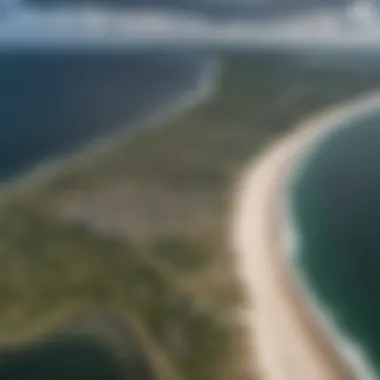

Weather radar is more than a tool; it’s a comprehensive resource that equips kiteboarders with the necessary knowledge to navigate the ever-changing weather of Eastpoint, making every outing a safe and thrilling adventure.
Understanding Local Weather Patterns
Understanding local weather patterns is a crucial aspect for kiteboarders in Eastpoint, FL. Kiteboarding is not just about enjoying the thrill of riding the waves but also about navigating the intricacies of the ever-changing weather conditions. Strong winds, sudden rain showers, and shifting temperatures can make or break a kiteboarding session. Therefore, having a solid grasp of local weather patterns helps kiteboarders make informed decisions, ensuring safety and optimal performance on the water.
Seasonal Variations
In Eastpoint, the weather sees significant seasonal variations that kiteboarders should be well aware of. Spring often brings unpredictable weather, with gusty winds and occasional storms that can crop up without much warning. This is an ideal time for experienced kiteboarders who can handle varied conditions but might pose challenges for novices.
During summer, the heat takes center stage, along with relatively stable wind conditions. The trade winds can provide consistent riding conditions, making for a popular period among local enthusiasts. However, one should also be vigilant about afternoon thunderstorms that are common in this season.
Fall is yet another transitional phase where weather can be a mixed bag. The winds start to shift, often providing some of the best conditions for kiteboarding, coupled with milder temperatures. This is typically seen as the sweet spot for many kiteboarders eager to catch those perfect breezes. Finally, winter might bring less frequent chances for kiteboarding due to colder temperatures and lower wind speeds, making it a time for rest or alternative water sports. The transitions between these seasons can dramatically affect wave conditions and wind patterns, influencing when and where to kiteboard.
Impact of Geography on Weather
The geography of Eastpoint plays a significant role in shaping its local weather patterns as well. Located along the Gulf Coast, kiteboarders must pay special attention to coastal winds and tidal influences that can vary based on proximity to landforms like bays and peninsulas. For instance, the presence of nearby land can create wind shadows, resulting in calm areas that are not suitable for kiteboarding if conditions are otherwise promising on the water's surface.
Furthermore, the orientation of the coastline can dictate wind patterns. With predominant winds generally coming from the southeast in summer, kiteboarders benefit from this geographical aspect as it provides ideal angles for riding along the shoreline.
The geographical features can also influence temperature variations—days on the water can feel markedly warmer thanks to local land breezes encouraging a unique microclimate. It’s important for kiteboarders to consider these geographical nuances to plan their sessions effectively, as they directly impact safety and performance. Remember, one false move could lead to a rough experience, so being in tune with the surroundings is essential.
Understanding local weather patterns means safer sessions and better rides. Kiteboarders can optimize their time on the water by observing and interpreting geographical impacts on weather.
By keeping a close eye on these seasonal variations and geographical influences, kiteboarders can maximize their enjoyment and safety, turning potentially adverse conditions into exhilarating opportunities.
Interpreting Weather Radar Data
Understanding how to interpret weather radar data is essential for kiteboarders looking to make the most of their time on the water. It’s like cracking a secret code—that when deciphered, can mean the difference between a thrilling session and a day stuck on the beach.
Radar visuals provide crucial insights into precipitation levels, storm movements, and wind strength. By learning to analyze these elements, kiteboarders can better predict conditions, thereby enhancing outcomes during their sessions.
Deciphering Precipitation Maps
Precipitation maps are a fundamental aspect of weather radar data. Essentially, they show where rain or other moisture is currently located and how it’s expected to move. For kiteboarders, it’s vital to distinguish between light, moderate, and heavy precipitation on these maps.
- Light precipitation often means that conditions might still be suitable for kiteboarding. It's the kind of weather where a slight drizzle won’t ruin your day.
- Moderate rain can signal approaching storm systems. Visibility could be reduced, and gear could get wet, possibly detracting from the experience.
- Heavy precipitation, however, is a red flag, indicating that conditions can turn hazardous. High winds often accompany these downpours, creating potentially dangerous situations for those out on the water.
When interpreting these maps, pay close attention to movement patterns. If precipitation is moving towards the area where kiteboarding takes place, it may be wise to reconsider the timing of your session, or even to explore other locations.
"Knowing when to steer clear of the water can save your gear and your safety."
Analyzing Wind Patterns
Wind patterns are perhaps the most critical aspect a kiteboarder needs to monitor. Radar systems can provide wind direction and speed, which can significantly impact kiteboarding performance. Interpreting this data allows kiteboarders to assess whether conditions are just right for flying high or if it would be better to sit things out.
When analyzing wind patterns, kiteboarders should look for:
- Wind direction: This tells you where the wind is coming from. Ideally, you want an onshore or sideshore wind, as these conditions are safer and more favorable for kiteboarding.
- Wind speed: Understanding the strength of the wind is crucial. For beginners, anything above 20 mph might be challenging, while experienced riders may seek out strong winds for some extreme maneuvers.
By staying attuned to wind patterns, kiteboarders can not only enhance their own experience but also help teammates and fellow enthusiasts on the water. It’s about creating a shared understanding of the conditions, ensuring that everyone can enjoy the ride safely.
In sum, effective interpretation of weather radar data arms kiteboarders with the knowledge needed to make informed decisions about when and where to kiteboard. With the right insight, you'll be ready to ride the wind and water with confidence.
Safety Considerations for Kiteboarders
Kiteboarding is certainly exhilarating; however, it isn't without its fair share of risks. Safety considerations are vitally important in ensuring that both novice and experienced kiteboarders engage in this sport with minimal risk. This section focuses on key elements that include understanding the potential hazards, effectively assessing risk factors, and implementing safety protocols based on weather conditions. By being informed and prepared, kiteboarders in Eastpoint, FL can enjoy their time on the water without unnecessary worries.
Assessing Risk Factors
When you step out to the water with your kite in hand, it's crucial to have a clear sense of the risk factors involved. These factors can change rapidly, influenced by local weather patterns, geographical features, and human behavior. Here are a few notable things to consider:
- Weather Conditions: Variability in weather affects wind speeds, precipitation, and any developing storms. Familiarity with local forecasts, radar reports, and how to interpret them can make all the difference.
- Experience Levels: Differing skill levels among kiteboarders can lead to incidents if beginners are not appropriately supervised, especially in crowded locations.
- Physical Condition: Kiteboarding demands a certain level of fitness and stamina. Swimmers should assess their physical limits, ensuring they’re up for the strength required to control the kite and board.
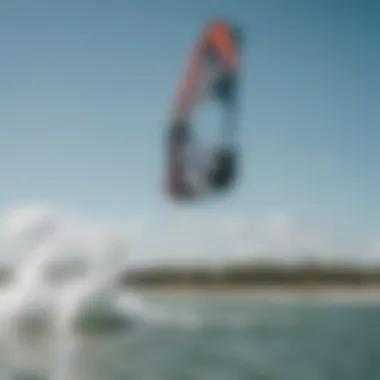

To better assess these risk factors, the use of weather radar can be a kiteboarder’s best friend. Monitoring the wind speed and direction through live or recent radar data can preemptively address potential dangers.
Safety Protocols Based on Weather Conditions
Understanding the forecasts is one thing, but knowing how to react is where the real safety measures come into play. Kiteboarders should establish a set of safety protocols, adapting these according to specific weather conditions. Here are some fundamental guidelines:
- Before Heading Out: Check for warnings related to thunderstorms, wind gusts exceeding safe limits, or unusual patterns in the weather. Websites like wikipedia.com or reddit.com can provide user insights on radar developments.
- During Your Session: Make regular assessments of conditions while on the water. If wind speed appears to increase dramatically, it may be time to wrap up or at least take a break.
- Emergency Measures: Always have a defined plan. Knowing how to signal for help, or where the nearest safe spot is can save lives. As an added layer of protection, always kiteboard with a buddy whenever possible.
"Preparation and awareness can often mean the difference between a thrilling session and a dangerous situation."
By integrating these risk assessments and protocols, kiteboarders can enhance their safety and overall enjoyment on the waters of Eastpoint. Building a culture of awareness and responsibility will not only benefit individual kiteboarders but make for a safer community as a whole.
Technological Advances in Weather Radar
Advancements in technology have revolutionized the field of weather radar, bringing significant improvements that directly resonate with recreational activities like kiteboarding. The evolution from basic radar systems to highly sophisticated technologies plays a crucial role in ensuring safety and enhancing kiteboarding experiences. Understanding these advancements is vital not only for the athletes but also for instructors and organizers who aim to provide a safe and enjoyable activity for participants.
New Developments
Recent innovations in weather radar technology have marked a leap forward in meteorological accuracy and reliability. For instance, dual-polarization radar has transformed the way precipitation is observed and forecast. This technology enables the radar to send and receive signals in both horizontal and vertical orientations, allowing for a more detailed analysis of particle size and shape. Such data can help foresee rain or storms that could affect kiteboarding conditions. As a kiteboarder, knowing the precise nature of impending weather means the difference between a thrilling session and a risky outing.
Consider also the development of higher-resolution radar systems. These provide clearer and more precise images of weather patterns, which can be instrumental when planning a kiteboarding session. With sharper images, kiteboarders can spot microbursts of wind or localized storm cells that might not have been easily identified with older technology. This kind of detailed information helps inform decisions about when and where to hit the water, reducing the risk of dangerous conditions.
"With cutting-edge radar technologies, the future of kiteboarding safety looks promising. The ability to predict swiftly changing weather patterns makes for smarter kiteboarding planning!"
Future Potential for Kiteboarding
The potential future advancements in weather radar can further shape the kiteboarding landscape in Eastpoint, FL, making experiences safer and more enjoyable. As machine learning and artificial intelligence continue to develop, we can expect more personalized weather forecasts tailored specifically for kiteboarders. These systems can analyze historical data, current weather patterns, and even user preferences to generate forecasts that align with the best kiteboarding conditions.
Another exciting prospect is the integration of radar data with mobile applications. Imagine a scenario where you can receive real-time updates on wind conditions, storm warnings, or even safety advisories directly through your smartphone. Such innovations not only create a platform for better communication among kiteboarders but also enhance collective safety measures, as users can share updates with one another about local conditions.
As radar technologies continue evolving, kiteboarders can expect improved features that help them anticipate changes in weather with far greater accuracy. This kind of foresight will enable enthusiasts to make the most of their time on the water, ensuring that every session is packed with excitement and minimal risk.
Resources for Kiteboarders
The resources available to kiteboarders are vital for ensuring both safety and enjoyment on the water. In Eastpoint, Florida, understanding how to effectively utilize these resources can make all the difference between a thrilling ride and a hazardous outing. These tools serve as the backbone for reliable information; without them, one could easily find themselves navigating tricky conditions blindly. Key resources include local weather stations and online weather tools and apps, each designed to cater to the unique challenges kiteboarders face.
Local Weather Stations
Local weather stations play a crucial role in the kiteboarding landscape of Eastpoint, providing hyper-local forecasts that can make or break a day on the water. Unlike broader weather reports, these stations focus on the specific climatic nuances of the area, giving detailed insights into temperature, humidity, and—most importantly—wind speed and direction.
- Timely Updates: Local stations often update their data in real-time, allowing kiteboarders to make informed decisions just before heading out. Whether it’s a sudden shift in wind patterns or an unexpected increase in precipitation, staying ahead of these changes is paramount.
- Tailored Forecasts: Because their primary goal is to serve the local community, these stations often cater specifically to recreational activities like kiteboarding, which means their reports are finely tuned to the needs of enthusiasts.
- Accessibility: Many local weather stations offer mobile-friendly websites, enabling kiteboarders to check conditions while on the go. Being able to access this information directly from the beach or the launch area can enhance decision-making on the fly.
"The most accurate readings from local stations can be the difference between a successful kiteboarding session and a day spent waiting for conditions to improve."
Online Weather Tools and Apps
In an age where information is just a few taps away, kiteboarders have access to an array of online weather tools and applications that simplify the forecasting process. These digital resources complement local weather stations and offer additional layers of detail.
- Popular Apps: Applications like Windy, KiteSurfing Weather, and iKitesurf are tailored specifically for water sports, offering features like wind maps and tide predictions.
- Interactive Features: Many online tools allow users to visualize weather conditions through animated maps and graphs, enabling kiteboarders to analyze trends over time.
- Community Input: Platforms like Reddit or specialized kiteboarding forums can offer anecdotal insights—often in real-time—from fellow kiteboarders about current conditions, enabling a more dynamic understanding of the environment.
- Custom Alerts: Users can set preferences to receive alerts for specific conditions like wind strength and direction within their desired range, ensuring they won’t miss the perfect day on the water.
Closure: Navigating Weather for Optimal Kiteboarding
In the realm of kiteboarding, particularly in a location as vibrant as Eastpoint, the relationship between weather radar and safe, enjoyable experiences on the water cannot be overstated. For kiteboarders, the ability to effectively interpret weather conditions can spell the difference between an exhilarating day on the water and a hazardous outing. Throughout this article, we've explored various facets of weather radar technology, its practical applications, and how they specifically relate to kiteboarding.
Summarizing Key Points
As we bring this discussion full circle, it's crucial to recap the main elements that contribute to a successful kiteboarding experience in Eastpoint:
- Understanding Local Weather Radar: Familiarizing oneself with local radar systems enables kiteboarders to make informed decisions. This knowledge allows for better anticipation of weather changes, especially when planning for wind and precipitation.
- Analyzing Radar Data: Recognizing how to interpret radar data effectively—for instance, distinguishing between safe and dangerous conditions—empowers both novice and seasoned kiteboarders.
- Influence of Geography: The unique geographical features of Eastpoint affect wind patterns and weather development. Hence, local knowledge is invaluable in navigating these elements.
- Safety and Preparedness: Lastly, the emphasis on safety considerations cannot be ignored. Being savvy about weather conditions leads to not only improved performance but also kept risk levels low. This is vital for anyone serious about kiteboarding.
Encouraging Responsible Kiteboarding Practices
Promoting best practices among kiteboarders goes hand in hand with weather awareness. Here are some vital considerations:
- Stay Updated: Regularly check forecasting updates and radar data before heading out. Local weather stations and online tools should become a part of your prep routine.
- Respect Conditions: If weather conditions seem questionable—be it high winds or storms—it's wise to stay off the water. Kiteboarding can be thrilling, but ensuring your safety is paramount.
- Proper Gear: Use kiteboarding gear that is appropriate for the weather and wind conditions to enhance safety and performance.
- Educate Peers: Share your knowledge about weather patterns and radar interpretation with other kiteboarders. A community that understands weather ensures a more enjoyable and secure environment for all.
"Weather radar isn’t just about forecasting; it's a lifeline for kiteboarders navigating sometimes unpredictable conditions."
By being proactive and informed, kiteboarders in Eastpoint can truly maximize their experiences on the water. Understanding the nuances of weather radar and the implications they have on kiteboarding is not just beneficial; it’s essential. This deeper awareness leads one to not only enjoy the thrill of flying across the waves but to do so with a level of safety paramount in water sports. Overall, thorough understanding and responsible practices create a positive environment where kiteboarding flourishes.

